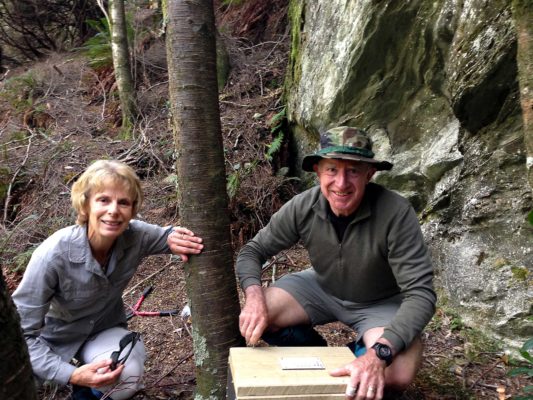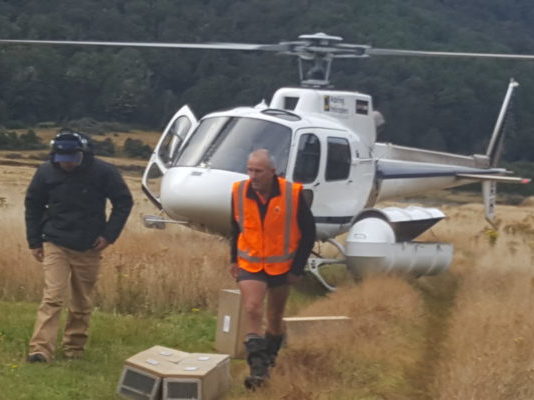The beautiful, remote Matukituki Valley is located between Mt Aspiring National Park and Lake Wanaka. It’s mossy beech forests, pristine glaciers, alpine plants and birdlife (including noisy kea on the hut roof), inspired a young James K. Baxter to write ‘Poem in the Matukituki Valley’ back in 1949. Today thousands of visitors come to explore the iconic southern forests and visit the Rob Roy Glacier.
But predators have discovered the glacier-carved river valleys too and in recent years the effect they are having has become increasingly noticeable. In 2013, Gillian and Derek Crombie decided it was time to fight back.

“We saw the value of the valley for recreation and introduction of young families to the outdoors environment and wanted to ensure that the encounters with birdlife that our family had enjoyed over the last 30 years would continue and improve,” Gillian says.
The noticeable decline in Kea numbers prompted a discussion with Paul Hellebrekers as DOC Wanaka manager and the Matukituki Charitable Trust (MCT) was formed to ensure birdlife is protected. The Trust has established a partnership agreement with Wanaka DOC staff and other like-minded groups such as the Kea Conservation Trust. They’re working to protect, restore and enhance the wildlife and plantlife of this unique patch of South Island backcountry.
Gillian describes the 2016/17 season just ended as the Trust’s “busiest and most challenging year!”
“Due to the dedication and determination of Paul Hellebrekers (now MCT Operations Manager) and our team of volunteers, 657 traps have been installed in the valley, implementing the first phase of the Trust’s trap installation efforts,” she says.
In the season to the end of May 2017, those traps had recorded 780 kills, including 95 stoats, 117 possums and 130 rats.
“For the first time we have encountered a number of cats, with 12 caught,” Gillian says.

In response, the Trust plans to install 40 cat-specific traps next year.
To date, the cost of traps purchased is almost $100,000. Fortunately the Trust is well supported by volunteers and financial supporters. In the last year, volunteers contributed 2,636.5 hours, while the MCT provided $37,000 to fund the restoration project.
“To maintain all the activities long term, we are budgeting around $50,000 per year,” says Gillian. “That will enable us to engage some assistance to check and maintain the trap network as well as extending some of the key trap lines that provide protections to kea and rock wren.”
Total funding to date exceeds $140,000, with over 6,635 volunteer hours and considerable DOC hours in support since the project began in 2013.
“It shows that this effort to maintain and improve the valley does matter to people, who are willing to give time, money and skills to make a difference,” Gillian says. “And we are winning and seeing great improvements in birdlife activity.”
Birdlife is becoming more visible in the Valley, with confirmed sightings of kea, kaka, kakariki, bellbirds, kereru, falcon, morepork, South Island robin, fantail, tomtit, rifleman and rock wren. And it’s not just birds flying around the valley – rare long tail bats have been sighted too.
“Over the last few years we have seen considerable increase in the numbers of South Island robin, kakariki and even a few kereru,” Gillian says. “This is very exciting for Heather and Stu Thorne who nurtured the small robin population which were translocated by DOC from the Dart Valley in 2007 and 2008. Heather managed to catch and band 50 robins this year – a fantastic and patient result.”
Other contributions include 300 dozen trap eggs (funded by Stuart and Coleen Landsborough), radios to improve field safety (Tait Electronics) and Aspiring Helicopters Ltd who helped provide access to the higher trap lines. Southern Hemisphere Proving Grounds provide funding for Paul Hellebrekers position as Operations Manager and Longview Environmental Trust have sponsored bird monitoring surveys. The Crombies provide general MCT funding while the DOC Community Fund has covered much of the cost of traps and installation (excluding volunteer time).
The latest project – just completed – is the installation of 100 traps of various types to form a barrier at the entrance to the Matukituki Valley near Hells Gates, Cameron Flat.
“Mt Aspiring Station landowners, Randall and Alison Aspinall have generously agreed to MCT installing a tight grid of traps between the bluffs and the Otago Boys High School Lodge, to prevent animals migrating up the valley,” says Gillian. “Otago Boys High School students have expressed an interest in being involved in the project which is great!”

